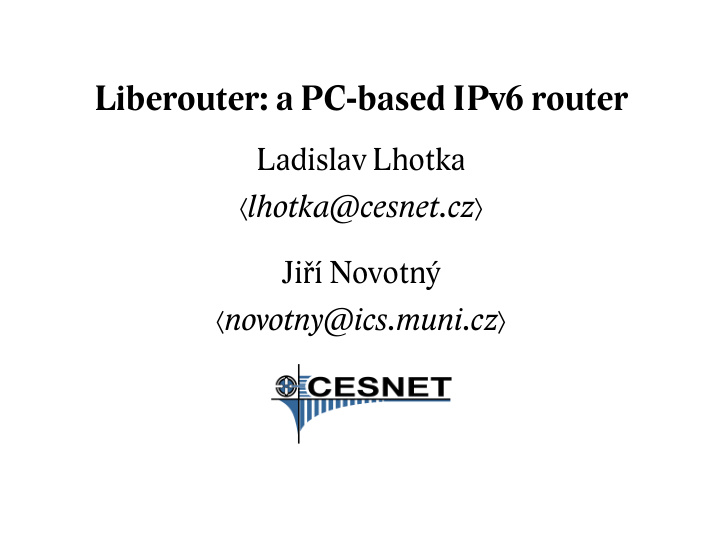



Liberouter: a PC-based IPv6 router Ladislav Lhotka 〈 lhotka@cesnet.cz 〉 Jiří Novotný 〈 novotny@ics.muni.cz 〉
Introduction • Routers and routing – complex technology, interesting algorithms inside the black (blue, violet) boxes • Liberouter: let’s do it ourselves, as a truly open research project (open-source licenses) • Flexible platform for network research, especially in IPv6 • Competitive solution for the network edge • Special functions: encryption, monitoring, traffic genera- tor • Commodity PC with additional hardware, lateras embed- ded systems • Support from CESNET and 6NET
Software PC router • In CESNET networks since early 1990s • Operating systems: KA9Q, PC Route, *BSD, Linux • Routing software: GateD, Zebra • Excellent experience, still in use in some MANs, national IPv6 backbone, m6bone • Limited forwarding performance (PCI and memory bus throughput, interrupt handling) • Inconsistent configuration through init scripts and con- figuration files
GE forwarding performance PC/Linux (PCI 64/66) Cisco 7500
• Dual-stack router with hardware acceleration: ⊲ Commodity PC with NetBSD or Linux ⊲ FPGA-based board: data plane in HW; control plane remains in SW ⊲ Throughput about 10 Gbps ⊲ Daughter interface cards (GE, 10GE, later POS) • Powerful and user-friendly configuration system ⊲ XML-based configuration repository ⊲ Bidirectional translation between XML and native con- figurations (Unix files, IOS, JUNOS), later XML-RPC
COMBO6 card
COMBO6 architecture Noprocessor,combinationofprogrammablehardwareand standard integrated circuits • Xilinx FPGA (Virtex II 3000–8000), CPLD • CAM, RAM, DRAM, PCI interface, power supply • Exchangeable interface cards • Test/extension connector
Firmware • Modular design • VHDL – standard development approach with simula- tion, requires expensive development environment • Concept of “nanoprocessors” makes simple reprogram- ming possible • Nanoprocessors are also simulated • Hardware/software co-design: algorithms are first imple- mented in software and their time-critical parts are grad- ually moved to hardware • Support from formal verification group
Packet processing PCI QUE LUP REP unif. header out in HFE OPE payload DRAM
System software • Development for NetBSD and Linux • COMBO6driverpresents thecard tothesystem asastan- dard 4-port Ethernet card • combo6 daemon with hooks in the OS: necessary changes are propagated into the COMBO6 card • Configuration can be done mostly by standard Unix utili- ties ( ifconfig , route , . . .) • Standard routing daemons can be used • tcpdump support
System software (cont.)
Current status • 4 COMBO6 cards manufactured and tested ( ∼ €3.500) • Interface card 4 × GE (copper) • Low-level driver for NetBSD and Linux • Development tools – comboctl , TCL scriptable • Intensive work on the firmware and software
Netopeer configuration system • Powerful platform-independent environment for config- uring large heterogeneous networks • Central configuration repository with version control • Internal data format based on XML • Netconf group in IETF: communication protocol (XML- RPC), not data contents • Netopeer development concentrates on configuration data and their transformations
Netopeer architecture SNMP legacy WWW metaconfig CLI XML configuration data conf. files XML-RPC SNMP
Current status • PreliminaryXMLschema(DTD):interfaceconfiguration (incl. VLANs and tunnels), packet and route filtering, static routes, RIP and RIPng. • Front-ends: Cisco IOS, JUNOS, web • Back-ends (XSLT): Cisco IOS, Linux/NetBSD
Further information • Project site – http://www.liberouter.org • All project files publicly available from CVS • Mailing lists • Project team has already 45 members, but contributors are still very welcome!
Recommend
More recommend